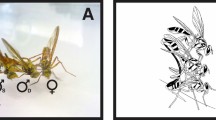Abstract
Same-sex sexual behaviors (SSSB) have been recorded in nearly all major animal groups and are often found in populations with skewed sex ratios (SR). Here, we study the role of sex ratios in the frequency of SSSB to better understand the conditions that give rise to such puzzling behaviors. We observed SSSB in multiple populations of the common fruit fly (Drosophila melanogaster) after manipulation of sex ratios. We also recorded male responses after being pursued by other males. We found more male-male sexual interactions in male-biased populations and a significant decrease of these behaviors after consecutive days of observation. Males pursued by other males reacted to such encounters. Our results provide support for the mistaken identity hypothesis, in which males are unable to differentiate between sexes at first encounter. With this work, we help elucidate possible social conditions that facilitate the appearance of such intriguing behaviors in nature.


Similar content being viewed by others
References
Bailey NW, French N (2012) Same-sex sexual behavior and mistaken identity in male field crickets, Telogryllus oceanicus. Anim Behav 84:1031–1038
Bailey NW, Zuk M (2009) Same-sex sexual behavior and evolution. Trends Ecol Evol 24:439–446
Bailey NW, Hoskins JL, Green J, Michael GR (2013) Measuring same-sex sexual behaviour: the influence of the male social environment. Anim Behav 86:91–100
Battesti M, Moreno C, Joly D, Mery F (2012) Spread of social information and dynamics of social transmission within Drosophila groups. Curr Biol 22(4):309–313
Curcillo PG, Tompkins L (1987) The ontogeny of sex appeal in Drosophila melanogaster males. Behav Genet 17:81–86
Dukas R (2006) Learning in the context of sexual behavior in insects. Anim Biol 56:125–141
Dukas R (2008) Evolutionary biology of insect learning. Annu Rev Entomol 53:145–160
Dukas R (2010) Causes and consequences of male-male courtship in fruit flies. Anim Behav 80:913–919
Ejima A, Griffith LC (2007) Measurement of courtship behavior in Drosophila melanogaster. Cold Spring Harb Protoc: https://doi.org/10.1101/pdb.prot4847
Field KL, Waite TA (2004) Absence of female conspecifics induces homosexual behavior in male guppies. Anim Behav 68:1381–1389
Gailey DA, Jackson FR, Siegel RW (1982) Male courtship in Drosophila: the conditioned response to immature males and its genetic control. Genetics 102(4):771–782
Han CS, Brooks RC (2015) Same-sex sexual behaviour as a by-product of reproductive strategy under male-male scramble competition. Anim Behav 108:193–197
Heyes CM (1994) Social learning in animals: categories and mechanisms. Biol Rev 69(2):207–231
Jallon JM (1984) A few chemical words exchanged by Drosophila during courtship and mating. Behav Genet 14:441–478
Liu T, Dartevelle L, Yuan C, Wei H, Wang Y, Ferveur JF, Guo A (2008) Increased dopamine level enhances male-male courtship in Drosophila. J Neurosci 28(21):5539–5546
Liu HH, Cao DD, Sethi S, Zeng Z, Chin JS, Chakraborty TS, Shepherd AK, Nguyen CA, Yew JY, Su CY, Wang JW (2016) Hormonal modulation of pheromone detection enhances male courtship success. Neuron 90(6):1272–1285
Mann J (2006) Establishing trust: socio-sexual behavior and the development of male-male bonds among Indian Ocean bottlenose dolphins. In: Sommer V, Vasey PL (eds) Homosexual behavior in animals: an evolutionary perspective, 1st edn. Cambridge University Press, New York, pp 107–130
McGraw KJ, Hill GE (1999) Induced homosexual behavior in the male house finch (Carpodacus mexicanus): the “prisoner effect”. Ethol Ecol Evol 11:197–201
McNamara JM, Szekely T, Webb JN, Houston AI (2000) A dynamic game-theoretic model of parental care. J Theor Biol 205(4):605–623
McRobert SP, Tompkins L (1988) Two consequences of homosexual courtship performed by Drosophila melanogaster and Drosophila affinis males. Evolution 42(5):1093–1097
McRobert SP, Tompkins L, Barr NB, Bradner J, Lucas D, Rattigan DM, Tannous AF (2003) Mutations in raised Drosophila melanogaster affect experience-dependent aspects of sexual behavior in both sexes. Behav Genet 33(3):347–356
Mery F, Varela SAM, Danchin É, Blanchet S, Parejo D, Coolen I, Wagner RH (2009) Public versus personal information for mate copying in an invertebrate. Curr Biol 19(9):730–734
R Core Team (2013) R: A language and environment for statistical computing. R Foundation for Statistical Computing, Vienna. http://www.R-project.org/
Scharf I, Martin OY (2013) Same-sex sexual behavior in insects and arachnids: prevalence, causes, and consequences. Behav Ecol Sociobiol 67:1719–1730
Scharf I, Peter F, Martin OY (2013) Reproductive trade-offs and direct costs for males in arthropods. Evol Biol 40:169–184
Siegel RW, Hall JC, Gailey DA, Kyriacou CP (1984) Genetic elements of courtship in Drosophila: mosaics and learning mutants. Behav Genet 14:383–410
Sommer V, Vasey PL (2006) Homosexual behaviour in animals: an evolutionary perspective. Cambridge University Press, New York
Spieth HT (1974) Courtship behavior in Drosophila. Annu Rev Entomol 19:385–405
Svetec N, Ferveur JF (2005) Social experience and pheromonal perception can change male-male interactions in Drosophila melanogaster. J Exp Biol 208:891–898
Thomas ML, Simmons LW (2009) Male-derived cuticular hydrocarbons signal sperm competition intensity and affect ejaculate expenditure in crickets. Proc R Soc Lond B Biol Sci 276(1655):383–388
Tompkins J, Hall C, Hall M (1980) Courtship-stimulating volatile compounds from normal and mutant Drosophila. J Insect Physiol 26:689–697
Vaias LJ, Napolitano LM, Tompkins L (1993) Identification of stimuli that mediate experience-dependent modification of homosexual courtship in Drosophila melanogaster. Behav Genet 23(1):91–97
Zhang SD, Odenwald WF (1995) Misexpression of the white (w) gene triggers male-male courtship in Drosophila. Proc Natl Acad Sci U S A 92(12):5525–5529
Acknowledgments
We extend our gratitude to Dr. Peter Newell, of the SUNY Oswego Department of Biological Sciences, for continuously supporting this research by providing live specimens, food supplies, and necessary equipment.
Author information
Authors and Affiliations
Corresponding author
Rights and permissions
About this article
Cite this article
Macchiano, A., Razik, I. & Sagot, M. Same-sex courtship behaviors in male-biased populations: evidence for the mistaken identity hypothesis. acta ethol 21, 147–151 (2018). https://doi.org/10.1007/s10211-018-0293-8
Received:
Revised:
Accepted:
Published:
Issue Date:
DOI: https://doi.org/10.1007/s10211-018-0293-8




